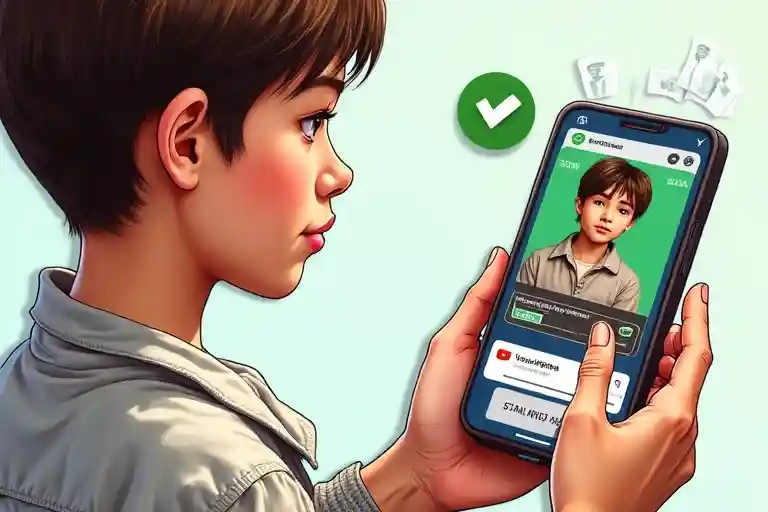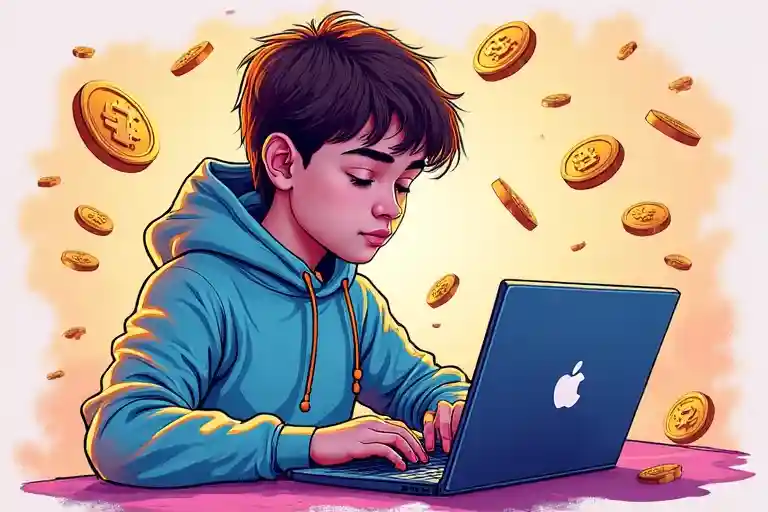Alright, let’s get REAL for a second. You’re scrolling TikTok, maybe catching up on the latest trends, and you hear whispers about “crypto.” Sounds complicated, right? Maybe even a little… sketchy? But what if I told you there’s a way to get into the crypto world, understand what it’s all about, AND get paid for it? Yes, you heard that right – PAID! We’re talking about learning rewards crypto programs. I was pretty mind-blown when I first discovered this (can you believe it?), and it’s not some get-rich-quick fantasy. It’s about companies literally giving you small amounts of cryptocurrency just for learning about their projects or different aspects of blockchain technology. So, ditch the idea that crypto is only for Wall Street gurus or tech geniuses. This is your chance to dive in, get educated, and maybe even score some digital cash for that thing you’ve been saving up for. We’re going to break down exactly what these programs are, how you, as a teen (especially if you’re in the US), can get involved (safely!), what platforms to check out, and how to make the most of these opportunities. Think of it like this: you know how in some games you complete quests and get rewards? This is kinda like that, but for your brain… and your future wallet! We’ll cover everything from “learn and earn” platforms to other cool ways to snag some free crypto. Ready to level up your knowledge and your crypto balance? Let’s GOOO!
Last updated: June 2025
What Exactly Are “Learning Rewards Crypto” Programs?
So, you’re probably thinking, “Okay, sounds cool, but what’s the catch with learning rewards crypto?” And that’s a smart question to ask! Basically, these programs are a way for cryptocurrency projects and exchanges to educate people about their specific coins, tokens, or the broader blockchain technology. Why would they *pay* you to learn? Well, think about it: the crypto world is new and can be confusing. For these projects to succeed, they need users who understand what they’re doing and what the project is about. It’s like a company giving out free samples of a new snack – they want you to try it, like it, and maybe tell your friends. In the crypto space, knowledge is power, and these companies are willing to give you a little crypto (the “reward”) in exchange for your time spent watching videos, reading articles, and sometimes taking short quizzes. It’s a win-win: you get free crypto and valuable knowledge, and they get a more informed user base. It’s not about getting rich overnight; it’s about a slow and steady way to accumulate some crypto while you actually understand what you’re holding. This is way different from, say, trying to day-trade, which can be super risky, especially for beginners. With learning rewards, the only investment is your time and willingness to learn – pretty awesome, right?
Why Do Companies Offer Free Crypto for Learning?
It might seem too good to be true, but there are solid reasons why companies dish out learning rewards crypto. First off, **user acquisition**. Crypto platforms and new coin projects need users, plain and simple. Offering a small amount of their token or a more installed one like Bitcoin or Ethereum for finishing academic modules is a superb manner to draw new people to their environment. It’s like while a brand new streaming service offers a free trial – they’re hoping you’ll stick round. Secondly, training and adoption. Blockchain technology continues to be quite new to maximum people. If customers don’t apprehend a mission, they’re not going to apply it or put money into it. By incentivizing learning, businesses assist demystify crypto and encourage broader adoption. Imagine trying to get humans enthusiastic about a awesome complex online game with out an instructional – it’d be hard! These getting to know modules are the tutorial. Lastly, it’s about building a community. When customers are knowledgeable approximately a challenge, they’re much more likely to emerge as lively and engaged individuals of its community, taking part in governance (for a few tokens) or really spreading the phrase. It’s a grassroots way to develop.
Are There Age Restrictions? (Super Important for Teens!)
Okay, this is a BIG one for all you teens out there. YES, there are often age restrictions for learning rewards crypto programs, especially those on major exchanges. Most centralized crypto exchanges require users to be 18 years or older to create an account and complete KYC (Know Your Customer) verification. This is due to financial regulations. So, if you’re under 18, platforms like Coinbase or Binance might be off-limits for direct sign-up. Does that mean you’re totally out of luck? Not necessarily! Some parents or guardians might be willing to sign up and let you use the learning modules under their supervision. This is something you’d *definitely* need to discuss with them. Honesty and transparency here are key – don’t try to sneak around age verifications, it can lead to account suspension and loss of any earned crypto. Think of it like needing your parents’ permission for certain apps or games; this is in a similar ballpark because it involves potential financial assets. Always, always check the platform’s terms of service regarding age *before* you even think about signing up. Safety first, always!
Learn and Earn Crypto for Free
The concept of “Learn and Earn crypto for free” is the core of what we’re talking about. These programs are specifically designed so you don’t need to invest any of your own money to get started. The “earn” part comes directly from the “learn” part. Typically, you’ll watch a series of short videos or read brief articles about a specific cryptocurrency. Each module usually focuses on a key feature, the problem the crypto solves, or how its technology works. After the educational content, there’s often a simple multiple-choice quiz. Get the questions right, and voilà, a small amount of that cryptocurrency is deposited into your account on the platform. It’s like getting rewarded for doing your homework, but instead of grades, you get crypto! This approach makes exploring different cryptocurrencies accessible and low-risk. You’re not buying anything; you’re earning it by proving you’ve absorbed some information. It’s a fantastic way to build a small, diversified crypto portfolio without opening your wallet, while also gaining genuine understanding, which is far more valuable than just getting “free stuff.” Remember that trending TikTok sound that’s like, “I am smart! S-M-R-T!”? That’s you after these modules, but with crypto.
How Do “Learn and Earn” Platforms Actually Work?
Let’s peek behind the curtain of these “Learn and Earn crypto for free” platforms. The process is usually pretty straightforward. First, you’ll need an account on a platform that offers these programs (we’ll talk about specific ones soon!). As mentioned, this might require parental involvement if you’re under 18. Once you’re in, you’ll find a dedicated “Learn and Earn” or “Rewards” section. Here, you’ll see a list of available cryptocurrencies offering rewards. You pick one, and it typically involves:
- Watching educational videos: These are often short, animated, and designed to be easy to understand, even if you’re new to crypto. They might explain what Bitcoin is, how smart contracts work, or the mission of a specific new token.
- Reading short articles: Sometimes, instead of or alongside videos, there will be brief lessons to read.
- Taking a quiz: After each lesson or a set of lessons, you’ll answer a few multiple-choice questions. Don’t sweat it too much; they’re usually based directly on the material you just covered. If you pay attention, you’ll likely ace them!
- Receiving your crypto: Once you pass the quiz, the advertised amount of crypto is credited to your platform wallet. Boom! You just earned crypto.
It’s a simple loop: learn, prove you learned, earn. The amounts per lesson are usually small – a few dollars worth of crypto – but they can add up, especially if you complete several different courses. Plus, the knowledge you gain is yours forever! For more details on beginner-friendly platforms, you might want to check out resources like this guide on crypto earning platforms for beginners.

Coinbase Learn and Earn
When you talk about learning rewards crypto programs, Coinbase Learn and Earn is often one of the first names that pops up. It’s one of the most well-known and established programs out there. Coinbase is a major cryptocurrency exchange, particularly popular in the United States, and they’ve put a lot of effort into making crypto accessible to newcomers. Their Learn and Earn feature allows users to discover how specific cryptocurrencies work and earn some of that crypto for their efforts. The process is exactly as described above: watch videos, take quizzes, and earn crypto. They regularly add new coins to the program, so there are often fresh opportunities. However, remember that big red flag for teens: Coinbase strictly requires users to be 18+ and complete identity verification. So, for most of you reading this, direct participation will require an adult’s account and their explicit permission and supervision. If your parents are crypto-curious themselves, this could be a cool activity to explore together! It’s a bit like when your parents had to help you set up your first email account – similar vibes, but with potential earnings!
How to Participate (If You Meet the Criteria or Have Help)
Assuming you’re 18+ or you have a parent/guardian who is willing to set up an account and let you learn under their watch, getting started with Coinbase Learn and Earn is fairly simple.
- Create a Coinbase Account: The adult will need to go to the Coinbase website, sign up, and complete the full identity verification process (KYC). This usually involves providing personal information and uploading an ID. This is standard for regulated financial platforms.
- Navigate to “Learn and Earn”: Once the account is set up and verified, look for the “Learning rewards,” “Earn,” or “Learn and Earn” section. It’s usually prominently displayed.
- Browse Available Campaigns: You’ll see a list of cryptocurrencies offering rewards. Each will show what you’ll learn about and how much you can earn.
- Start Learning: Pick a campaign, watch the videos, and read any provided material.
- Take the Quizzes: Answer the questions. Usually, if you get one wrong, you can try again.
- Receive Your Crypto: Upon successful completion, the crypto is added to the Coinbase account.
It’s important to note that sometimes there’s a waitlist for certain Learn and Earn opportunities due to high demand. Also, availability can vary by region. So, what you see might be different from what someone in another country sees. Patience is key! For those who do earn, thinking about a crypto profit taking strategy early on, even for small amounts, is a good habit.
Coinbase Learning Rewards Not Showing? Troubleshooting Tips
It can be a real bummer when you’re all set to start earning with Coinbase Learn and Earn, but the opportunities aren’t showing up, or it says “you are on the waitlist.” This is a common query – “Coinbase learning rewards not showing” is a frequent search. Here are a few reasons why this might happen and some things to check (again, this is for an eligible, verified account):
- Account Verification: The most common reason is that the account isn’t fully verified. Coinbase needs to confirm identity before offering rewards. Double-check that all KYC steps are complete.
- Eligibility Criteria: Coinbase has specific (and sometimes unpublished) eligibility criteria. This can include things like your region, trading history (though often not for learn and earn specifically), or account activity. Not everyone is eligible for every campaign.
- High Demand & Waitlists: Popular campaigns can fill up fast, or you might be placed on a waitlist. It’s like trying to get tickets for that viral concert – sometimes you gotta wait, or they run out.
- Geographic Restrictions: Learn and Earn programs are not available in all countries or regions. Make sure your region is supported.
- Technical Glitches: Sometimes, it’s just a temporary app or website glitch. Try logging out and back in, clearing your browser cache, or using a different browser/device.
- Program Availability: Coinbase rotates the cryptocurrencies in its Learn and Earn program. A campaign you heard about might have ended, or new ones might not be live yet.
If you’ve checked all these and still have issues, the account holder might need to contact Coinbase support directly. But often, patience or ensuring full verification is the solution.
Binance Learn and Earn
Another giant in the crypto exchange world, Binance, also offers its own “Binance Learn and Earn” program. Much like Coinbase’s version, it’s designed to educate users about different blockchain projects and reward them with crypto for completing courses and quizzes. Binance has a massive global presence and offers a huge variety of cryptocurrencies, so their Learn and Earn section can sometimes feature a diverse range of projects. The core mechanics are the same: learn, get quizzed, earn. And, just like Coinbase, Binance has strict KYC and age requirements (typically 18+). So, for teenagers, the same advice applies: this is likely a no-go without direct parental involvement and use of their account. It’s important to respect these rules. Think of it like this: you wouldn’t try to drive a car without a license and proper age, right? Financial platforms have rules for a reason, mainly to protect users and comply with regulations. If you’re curious about tracking potential profits from these earnings, even if small, tools like a crypto profit calculator for Binance could be interesting to explore conceptually with a parent.
Comparing Binance and Coinbase for Learning Rewards
When it comes to learning rewards crypto, both Binance and Coinbase are top players, but they have slight differences.
**Coinbase Learn and Earn:**
- Pros: Extremely user-friendly interface, great for absolute beginners. Often features well-established and up-and-coming projects. Strong presence in the US.
- Cons: Can have waitlists for popular rewards. Eligibility can be a bit opaque. Fewer coins offered compared to Binance at times.
**Binance Learn and Earn:**
- Pros: Often a wider variety of coins available due to Binance’s larger ecosystem. Rewards can sometimes be slightly higher for certain campaigns. Global reach.
- Cons: The Binance platform can be a bit more overwhelming for complete beginners compared to Coinbase’s simplicity. KYC can be very stringent. Availability of specific campaigns can vary significantly by region.
For American teens (with parental help), Coinbase might feel a bit more straightforward to navigate initially. However, if the adult account holder is comfortable with a more complex interface, Binance might offer more variety over time. The key is that *both* platforms offer legitimate ways to learn and earn, provided all rules are followed. It’s not really an “either/or” – an eligible person could potentially use both! It’s like choosing between TikTok and Instagram – some people use both for different things!

Free Crypto Instantly? Managing Expectations
The idea of “Free crypto instantly” sounds amazing, doesn’t it? And yes, with learning rewards crypto programs, once you complete a lesson and quiz, the crypto is often deposited into your account fairly quickly, sometimes within minutes or hours. So, in that sense, it *is* pretty instant! However, it’s crucial to manage expectations. We’re not talking about getting rich instantly. The amounts you earn per lesson are typically small – think a few dollars’ worth of a particular crypto. It’s designed as an incentive to learn, not a way to make a full-time income. That TikTok trend where someone expects a mountain of cash and gets a single coin? That’s the kind of expectation adjustment needed here. The *real* value is the knowledge you gain and the small bits of crypto that can add up over time or potentially grow in value if the projects succeed. So, while the deposit might be “instant,” building a significant amount takes time and effort across multiple learning opportunities. Don’t fall for anything that promises huge amounts of free crypto instantly with no effort – those are usually scams!
How “Instant” Are We Talking?
When we say “Free crypto instantly” in the context of learn and earn programs, “instantly” usually means within a few minutes to a few hours after successfully completing a quiz. The platform’s system typically verifies your quiz completion and then processes the crypto transfer to your account wallet on that platform. It’s generally an automated process, so it’s quite fast. You likely won’t be waiting days or weeks for these small rewards. However, “instantly” doesn’t mean the crypto will instantly make you wealthy, or that you can instantly withdraw it to an external wallet or bank account without any conditions. There might be minimum withdrawal amounts on the platform, or the earned crypto might be “locked” for a short period in some specific promotions (though less common for standard learn and earn). So, yes, the reward hits your account quickly, which is super satisfying! Just remember it’s a small, satisfying step, not a giant leap to riches.
| Method | Typical Time Investment | Skill Required | Potential Earnings (Initial) | Parental Involvement (Under 18) | Risk Level |
|---|---|---|---|---|---|
| Learning Rewards Crypto | Low (minutes per lesson) | Low (basic comprehension) | Low (few $ per lesson) | High (account setup, supervision) | Very Low (if platform is legit) |
| Crypto Faucets | Low (seconds/minutes per claim) | Very Low (clicking, captchas) | Extremely Low (fractions of a cent) | Moderate (platform safety check) | Low (but watch for scammy sites) |
| Crypto Airdrops | Moderate (researching, completing tasks) | Low to Moderate (social media, basic wallet use) | Variable (can be $0 or more, speculative) | High (wallet setup, security, task safety) | Moderate (many scams, token value volatile) |
| Play-to-Earn Games (Free-to-Start) | High (significant gameplay time) | Moderate to High (gaming skills) | Variable (can be low, depends on game & effort) | Moderate (game choice, time management) | Moderate (game sustainability, token value) |
Are “Learning Rewards Crypto” Programs Safe for Teens?
This is THE most important question when we talk about learning rewards crypto and teens. The learning part itself – watching videos, reading about technology – is generally very safe and educational. It’s like reading a science blog or watching an educational YouTube channel. The risk doesn’t usually come from the *learning* but from the *platform* and the *crypto* itself. Here’s the breakdown:
- Platform Legitimacy: Stick to well-known, reputable exchanges like Coinbase or Binance (with parental help for account creation if under 18). Random, unknown websites promising free crypto for learning could be scams designed to get your personal information or, worse, get you to connect a wallet to a malicious site. It’s like avoiding that sketchy pop-up ad that promises a free iPhone – if it sounds too good to be true from an unknown source, it probably is.
- Age Restrictions & KYC: As hammered home, most legit platforms are 18+. Trying to bypass this can lead to problems. This is a safety measure for YOU. Financial products, even “free” crypto, come with responsibilities.
- Parental Guidance: This is non-negotiable for teens. Parents or guardians should be involved in setting up accounts (if they choose to), understanding what information is being shared, and overseeing the activity. They can help you spot red flags.
- Understanding Crypto Volatility: The crypto you earn is “real” crypto. Its value can go up OR down, a lot! Don’t get emotionally attached to the dollar value you see one day; it could be very different the next. The learning aspect is more stable than the monetary value.
- Security: Once crypto is earned, even small amounts, it needs to be kept secure. This means strong passwords (for the platform account, managed by the adult), and understanding basic online safety – don’t share login details, be wary of phishing emails pretending to be from the platform.
So, are the programs safe? The *concept* of learning and getting a small reward is. The *practice* requires caution, sticking to reputable platforms, and DEFINITELY involving parents for anyone under 18. Consider looking into ways for crypto passive income as a next step, but only after mastering the basics safely.
Beyond Learn & Earn: Other Ways Teens Can Get Crypto (with Caution!)
While learning rewards crypto programs are a fantastic starting point, there are a couple of other avenues teens sometimes explore to get free crypto, though these come with their own set of cautions and often require even more diligence. Two of the most talked-about are crypto faucets and airdrops.
Crypto Faucets: Tiny Drips of Crypto
Imagine a dripping faucet – each drop is tiny, but eventually, they can fill a cup. Crypto faucets are websites or apps that give out minuscule amounts of cryptocurrency for completing simple tasks, like clicking a button, watching an ad, or solving a CAPTCHA. We’re talking fractions of a cent per claim. Why do they do this? Usually, to drive traffic to their site so they can earn from ads.
Are they legit? Some are, but many can be time-wasters or even a bit sketchy, filled with pop-ups and potentially leading to less reputable sites. It takes a *lot* of clicks and time to earn anything noticeable. For example, the best crypto faucets in 2025 might be listed on review sites, but even then, the earnings are very small.
**For Teens:** If you explore these (with parental awareness), stick to well-reviewed faucets, use a dedicated email address (not your main one) to avoid spam, and never download anything suspicious. And honestly? The time spent might be better used on more substantial learning rewards programs. Is clicking for 0.0001 cents really how you want to spend your afternoon? Probably not as fulfilling as actually learning something!
Crypto Airdrops: Free Tokens, But Do Your Homework!
Crypto airdrops are when new (and sometimes existing) crypto projects distribute their tokens for free to build a community and raise awareness. It’s like a company giving away free shares to early supporters. To qualify, you might need to perform tasks like following the project on social media, joining their Telegram group, or holding a certain other cryptocurrency in your wallet. Lists of potential airdrops can be found on sites like Airdrops.io.
Sounds like free money, right? Well, kinda. The catch is that many airdropped tokens have little to no value initially, and many projects fail. There are also MANY airdrop scams designed to steal your existing crypto or personal data by asking you to connect your wallet to a fake site or share your private keys (NEVER DO THIS!).
**For Teens:** Airdrops are generally more advanced and riskier than learn-and-earn programs. You’ll need a crypto wallet (which has its own learning curve and security responsibilities), and you need to be *super* careful about scams. If you’re interested, this is 100% something to research *with* a crypto-savvy adult. The allure of “free tokens” can be strong, but losing your existing crypto (if you have any) to a scam is a harsh lesson. Approach with extreme caution and skepticism. Focus on the learning aspect and official announcements from projects, not random DMs promising riches.
Understanding the Basics: What IS Crypto Anyway? (For Teens)
Before you get too deep into earning it, let’s quickly cover what this “crypto” stuff actually is, because understanding is key for learning rewards crypto. Imagine digital money, but instead of a bank keeping track of it, a giant, shared, super-secure spreadsheet called a “blockchain” does. This blockchain is spread across thousands of computers worldwide, making it really hard to hack or cheat. Bitcoin was the first big one – you’ve probably heard of it. It’s like the OG digital gold. But now there are thousands of different cryptocurrencies, each with its own purpose. Some, like Ethereum, are like giant world computers that can run “smart contracts” – bits of code that automatically do stuff when certain conditions are met (like releasing your earned crypto after you pass a quiz!). Others are designed for specific games, social media platforms, or to solve particular problems like making international payments faster and cheaper. It’s a bit like how there are different apps on your phone for different things; there are different cryptos for different uses. The “crypto” part comes from “cryptography,” which is the fancy math that keeps it all secure. So, when you’re earning these learning rewards, you’re getting tiny pieces of these different digital assets. Pretty cool tech, huh?
Why is Crypto Volatile? (The Rollercoaster Ride)
You’ll hear this word a LOT with crypto: **volatile**. It basically means the price can go WAAAY up and WAAAY down, really fast. Like, one day your $5 worth of earned crypto might be worth $7, and the next it could be $3. It’s like the biggest rollercoaster at the theme park – exciting, but also a bit scary if you’re not prepared! Why? Several reasons:
- It’s New: The whole crypto market is still pretty young compared to things like stocks. New things often have a lot of price swings as people figure out their true value.
- Supply and Demand: Just like concert tickets for a mega-popular artist, if lots of people want a certain crypto and there’s not much of it, the price goes up. If people lose interest, it goes down.
- News and Hype: A single tweet from someone famous (hey, Elon!) or big news about regulations can send prices soaring or crashing. It’s very sensitive to internet buzz – kinda like how a TikTok dance can go viral overnight and then be forgotten a week later.
- Speculation: A lot of people buy crypto hoping the price will go up so they can sell it for a profit. This “speculation” can drive prices up quickly but also lead to sharp drops.
This is why the “learn” part of learning rewards crypto is so important. The crypto you earn is cool, but don’t bank your lunch money on its value doubling overnight. Treat it as a bonus for learning, not a guaranteed path to riches.
Learning Rewards Crypto Login: Staying Safe
When you engage with any platform offering learning rewards crypto login access, security is paramount. This usually refers to logging into an exchange like Coinbase or Binance (with parental help for the account). Here are some must-dos:
- Strong, Unique Passwords: Don’t use “password123” or your pet’s name. Use a long, complex password that’s different from your other online accounts. A password manager can help the adult account holder generate and store these.
- Two-Factor Authentication (2FA): This is HUGE. 2FA adds an extra layer of security beyond just your password. It usually involves getting a code on a separate app (like Google Authenticator or Authy) or via SMS (though app-based is generally more secure). Most reputable exchanges require or strongly recommend it. Think of it as having two locks on your door instead of one.
- Beware of Phishing: Scammers will try to trick you into giving up your login details. They might send fake emails that look like they’re from the exchange, or create fake login pages. *Always* double-check the website URL before entering login info. If you get an email asking for your password or private keys, it’s a SCAM. Legitimate platforms will NEVER ask for these.
- Secure Your Email: The email address associated with the crypto account needs to be super secure with its own strong password and 2FA. If a hacker gets into your email, they might be able to reset your exchange password.
- Log Out: When you’re done, especially on a shared computer, log out of the exchange.
Remember, even if you’re just doing the learning part and an adult is managing the account, understanding these safety tips is crucial for everyone involved. It’s like knowing not to share your debit card PIN – same principle!
Conclusion
Wow, we’ve covered a TON about learning rewards crypto! From understanding what these programs are, to how platforms like Coinbase and Binance operate them (with the big 18+ asterisk!), and even touching on other ways to get free crypto like faucets and airdrops (with even bigger caution signs!). The main takeaway? Learning about crypto can actually PAY YOU. It’s not about getting rich quick; it’s about gaining valuable knowledge in a super exciting and evolving tech space, and picking up some digital assets along the way. Think of it as a cool, modern way to learn and earn, perfect for curious teens. The digital world is changing fast, and understanding a bit about crypto could be really useful down the road. The most important things are to be safe, always involve your parents if you’re under 18, stick to reputable platforms, and manage your expectations. The journey of learning rewards crypto is just beginning!
What do you think? Are you excited to try and earn some crypto by learning? Got any questions we didn’t cover? Drop a comment below – let’s chat! And if you found this useful, why not share it with your friends on TikTok or Instagram? Spread the knowledge!
Stay Updated! The crypto world changes SUPER fast. New platforms pop up, and rules can change. Keep visiting Zana.website for the latest info on earning crypto and staying safe online. We’re always on the lookout for new opportunities for teens!
Frequently Asked Questions
1. Can I earn crypto by learning?
Yes, absolutely! Many cryptocurrency exchanges and projects offer “learn and earn” programs. You watch educational videos or read articles about specific cryptocurrencies or blockchain technology, then take short quizzes. If you pass, you receive a small amount of crypto as a reward. It’s a great way to get free crypto while gaining knowledge.
2. How do I get $200 free on Coinbase?
Coinbase occasionally has promotions or a combination of Learn and Earn opportunities that *might* add up over time, but getting a flat $200 instantly for free is unlikely and not a standard offer. “Learn and Earn” rewards are typically a few dollars per coin. Always check Coinbase’s official site for current promotions, and remember you usually need to be 18+ to have an account.
3. Can you make $100 a day with crypto?
Making $100 a day with crypto consistently is very difficult, especially for beginners, and usually involves high-risk methods like active trading or significant investment, not just learning rewards. While some people achieve this, it’s not typical or guaranteed and often requires deep expertise and capital. Learning rewards crypto programs will not generate this level of daily income.
4. Can you make $1000 a month with crypto?
Similar to making $100 a day, earning $1000 a month from crypto usually requires substantial investment, trading skills, or developing successful crypto-related projects, not just from simple tasks like learning rewards or faucets. These free earning methods provide small amounts. Aiming for $1000/month from them alone is unrealistic for most people, especially teens starting out.









